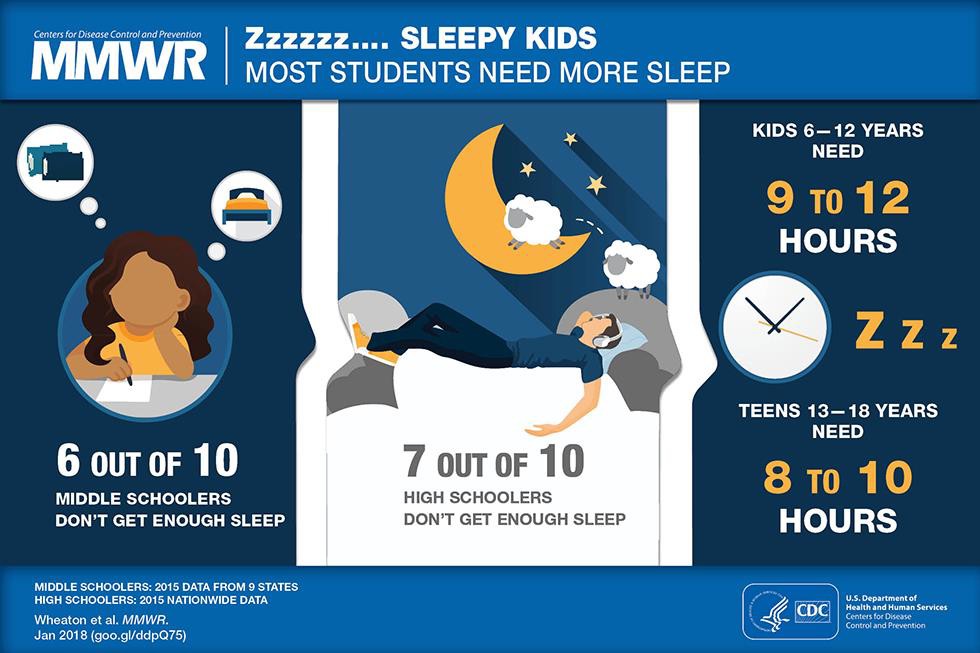116 Adolescent Health: Sleep, Diet, and Exercise
Sleep Health
According to the National Sleep Foundation (NSF) (2016), adolescents need about 8 to 10 hours of sleep each night to function best. The most recent Sleep in America poll in 2006 indicated that adolescents between sixth and twelfth grade were not getting the recommended amount of sleep. For the older adolescents, only about one in ten (9%) get an optimal amount of sleep, and they are more likely to experience negative consequences the following day. These include feeling too tired or sleepy, being cranky or irritable, falling asleep in school, having a depressed mood, and drinking caffeinated beverages (NSF, 2016). Additionally, they are at risk for substance abuse, car crashes, poor academic performance, obesity, and a weakened immune system (Weintraub, 2016).

Why don’t adolescents get adequate sleep? In addition to known environmental and social factors, including work, homework, media, technology, and socializing, the adolescent brain is also a factor. As adolescents go through puberty, their circadian rhythms change and push back their sleep time until later in the evening (Weintraub, 2016). This biological change not only keeps adolescents awake at night, it makes it difficult for them to get up in the morning. When they are awake too early, their brains do not function optimally. Impairments are noted in attention, behavior, and academic achievement, while increases in tardiness and absenteeism are also demonstrated. Psychologists and other professionals have been advocating for later school times, and they have produced research demonstrating better student outcomes for later start times. More middle and high schools have changed their start times to better reflect the sleep research.[1]

Video reviews how adolescents circadian rhythms change, the importance of sleep, and tips for getting adequate sleep.
Eating: Healthy Habits = Healthy Lives
The Dietary Guidelines define late adolescence, as the period from ages fourteen to eighteen. After puberty, the rate of physical growth slows down. Biological females stop growing taller around age sixteen, while biological males continue to grow taller until ages eighteen to twenty. One of the psychological and emotional changes that take place during this life stage includes the desire for independence as adolescents develop individual identities apart from their families. As teenagers make more of their dietary decisions, parents, caregivers, and authority figures should guide them toward appropriate, nutritious choices.

Some adolescents don’t have all the food necessary for proper development and may be food insecure. Most people have access to fresh water in all except the most extreme situations; the need for food is the most fundamental and important human need. More than 1 in 10 U.S. households contain people who live without enough nourishing food and this lack of proper nourishment has profound effects on their abilities to lead lives that will allow them to develop to their fullest potential. (Hunger Notes, n.d.).
When people are extremely hungry, their motivation to attain food completely changes their behavior. Hungry people become listless and apathetic to save energy and then become completely obsessed with food. Ancel Keys and his colleagues (Keys, Brožek, Henschel, Mickelsen, & Taylor, 1950) found that volunteers who were placed on severely reduced-calorie diets lost all interest in sex and social activities, becoming preoccupied with food.[2]
Healthy Habits
Forming good eating habits and engaging in fitness or exercise programs will help promote lifelong healthy habits.
The energy (calorie) requirements for preteens differ according to gender, growth, and activity level. For ages nine to thirteen, females should consume about 1,400 to 2,200 calories per day and males should consume 1,600 to 2,600 calories per day. Physically active preteens who regularly participate in sports or exercise need to eat a greater number of calories to account for increased energy expenditures.
Exercise improves our overall mental health by lowering stress and improving feelings of well-being. Exercise also increases cardiovascular capacity, lowers blood pressure, and helps improve diabetes, joint flexibility, and muscle strength (American Heart Association, 1998). For long lasting change, it’s important to plan healthy meals, limit snacking, and to schedule exercise into our daily lives.[3]
Eating Disorders
Although eating disorders can occur in children and adults, they frequently appear during the teen years or young adulthood (National Institute of Mental Health (NIMH), 2016). Eating disorders affect multiple genders, although rates among women are 2 1⁄2 times greater than among men. An individual with an eating disorder has a distorted sense of body image, which may include body dysmorphia or an extreme concern with becoming more muscular (Hudson, Hiripi, Pope, & Kessler, 2007; Wade, Keski-Rahkonen, & Hudson, 2011).

Video reviews symptoms and causes of a rising prevalence of eating disorders for boys.
Risk Factors for Eating Disorders
Researchers are finding that eating disorders are caused by a complex interaction of genetic, biological, behavioral, psychological, and social factors (NIMH, 2016). Eating disorders appear to run in families, and researchers are working to identify DNA variations that are linked to the increased risk of developing eating disorders. Researchers have also found differences in patterns of brain activity in women with eating disorders in comparison with healthy women.
The main criteria for the most common eating disorders: Anorexia nervosa, bulimia nervosa, and binge-eating disorder are described in the Diagnostic and Statistical Manual of Mental Disorders-Fifth Edition (DSM-5)(American Psychiatric Association, 2013) and listed in Table 6.1.[4]
|
Eating Disorder |
Description |
|
Anorexia Nervosa |
|
|
Bulimia Nervosa |
|
|
Binge-Eating Disorder |
|
Health Consequences of Eating Disorders
For those suffering from anorexia, health consequences include an abnormally slow heart rate and low blood pressure, which increases the risk for heart failure. Additionally, there is a reduction in bone density (osteoporosis), muscle loss and weakness, severe dehydration, fainting, fatigue, and overall weakness. Individuals with this disorder may die from complications associated with Anorexia nervosa, which has the highest mortality rate of any psychiatric disorder.
In this video, Dr. Rachel Goldstein uses three case studies to illustrate symptoms, causes, and interventions for anorexia.
The binge and purging cycle of bulimia can affect the digestives system and lead to electrolyte and chemical imbalances that can affect the heart and other major organs. Frequent vomiting can cause inflammation and possible rupture of the esophagus, as well as tooth decay and staining from stomach acids.
In this video, Dr. Rachel Goldstein outlines a case study and then reviews the definition of bulimia nervosa, common misconceptions of the eating disorder, and approaches to treatment. Please note, Dr. Goldstein discusses how bulimia may be comorbid with suicidal ideation.
Lastly, binge eating disorder results in similar health risks to obesity, including high blood pressure, high cholesterol levels, heart disease, Type II diabetes, and gall bladder disease (National Eating Disorders Association, 2016).
In this video, Dr. Rachel Goldstein reviews features of binge eating and treatment options. Please note, Dr. Goldstein discusses how eating disorders may be comorbid with suicidal ideation.
Eating Disorders Treatment
The foundations of treatment for eating disorders include adequate nutrition and discontinuing destructive behaviors, such as purging. Treatment plans are tailored to individual needs and include medical care, nutritional counseling, medications (such as antidepressants), and individual, group, and/or family psychotherapy (NIMH, 2016).[5]
Video briefly defines eating disorders, outlines some treatment options, and discusses why it can be difficult to recognize and treat eating disorders.

In the next section we will be looking at various psychological disorders. Learning about and supporting others seeking help when they have a mental health problem is just as important as seeking help when one is experiencing negative physical health problems.[6]
- Lifespan Development: A Psychological Perspective by Martha Lally and Suzanne Valentine-French is licensed under CC BY-NC-SA 3.0 ↵
- Nutrition through the Life Cycle: From Pregnancy to the Toddler Years by Maureen Zimmerman and Beth Snow is licensed under CC BY-NC-SA 3.0(modified by Dawn Rymond) ↵
- Beginning Psychology - Two Fundamental Human Motivations: Eating and Mating by Charles Stangor is licensed under CC BY-NC-SA 3.0 ↵
- Lifespan Development: A Psychological Perspective by Martha Lally and Suzanne Valentine-French is licensed under CC BY-NC-SA 3.0 ↵
- Lifespan Development: A Psychological Perspective by Martha Lally and Suzanne Valentine-French is licensed under CC BY-NC-SA 3.0 ↵
- 4Child Growth and Development by Jennifer Paris, Antoinette Ricardo, & Dawn Rymond licensed under CC BY 4.0 (sections modified by Courtney Boise) ↵

